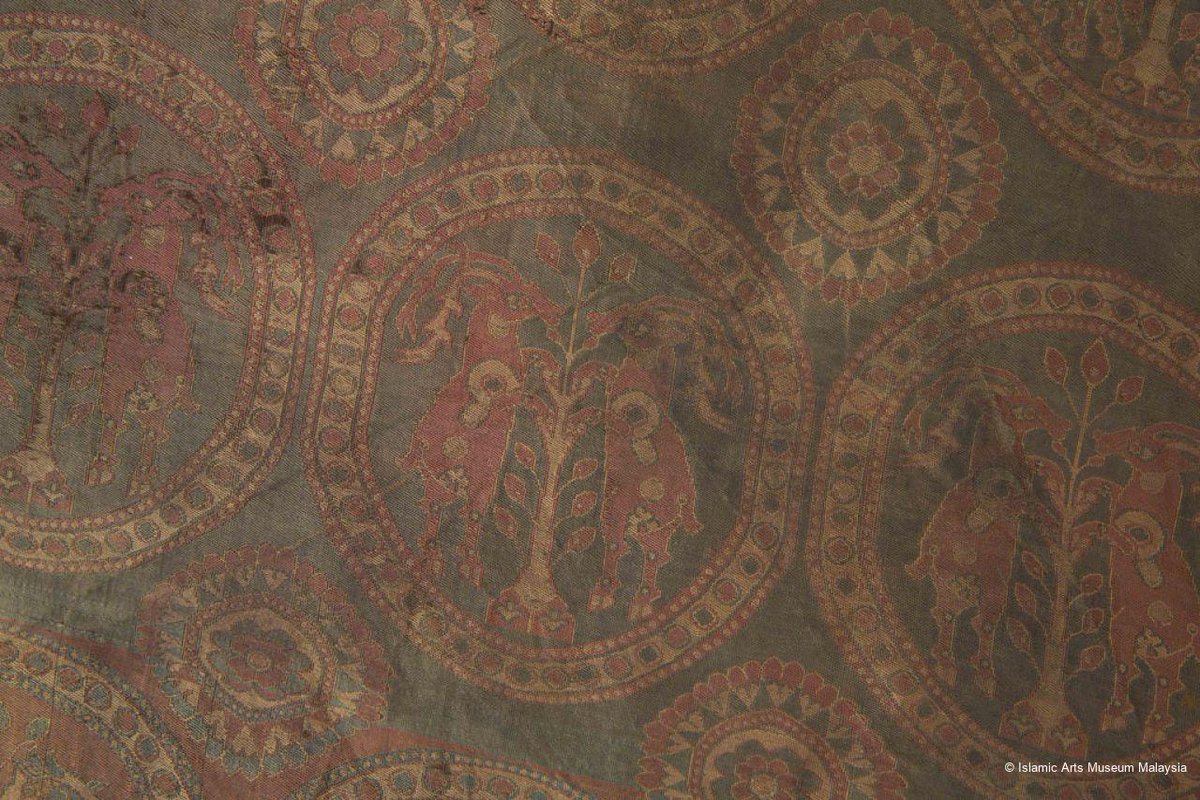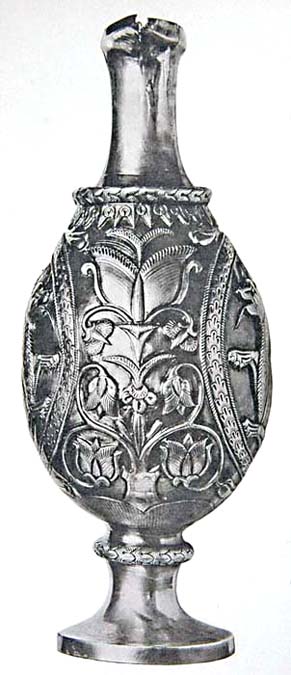24 #Iranian motifs & designs used for centuries from China to Rome: Part 3
۲۴ طرح و نقش ایرانی که از چین تا روم برای چند صد سال استفاده میشده.
No. 19) Mythological Creatures: Winged horse
⤵️🧵
۲۴ طرح و نقش ایرانی که از چین تا روم برای چند صد سال استفاده میشده.
No. 19) Mythological Creatures: Winged horse
⤵️🧵

I don't agree with Dr. Canepa. Oldest reps of winged horse are from Iran. At least they're from same time as those in Greece. Not to say later depictions didn't have some contact with Greek forms too, but winged horse/Pegasus has been an important Iranian mythological creature
... for millennia. See for example:
1: Sialk, 10-9 C BCE
2: from ancient Luristan, @MuseeLouvre
4: 8-7 C BCE, @metmuseum
⤵️



1: Sialk, 10-9 C BCE
2: from ancient Luristan, @MuseeLouvre
4: 8-7 C BCE, @metmuseum
⤵️




I'll just provide a few examples here. There are numerous seals, other depictions from Parthian, Sasanian eras!
4: @hermitage_eng
See other examples:
⤵️



4: @hermitage_eng
See other examples:
https://twitter.com/On_Persia/status/1506064516970332162?s=20&t=VdkefzZycd7qd7kyXa9G7A
⤵️




We then see the same design on textile
Here one more Sasanian plate
2: from Egypt, 6-7 C, @ Lyon
3-4: from Egypt, @ Louvre
Also note Sasanian scarf/ribbons on horse, crescent in roundels, winged horses in roundels, all Iranian designs
⤵️



Here one more Sasanian plate
2: from Egypt, 6-7 C, @ Lyon
3-4: from Egypt, @ Louvre
Also note Sasanian scarf/ribbons on horse, crescent in roundels, winged horses in roundels, all Iranian designs
https://twitter.com/On_Persia/status/1568394884415111168?s=20&t=kRh2gJKB-uZp_tSyEcPW_Q
⤵️




See this one specifically from Iranian lands, @ al Sabah collection
Silk samite, eastern Iran, 5-6 C, reportedly from Samangan Province, northern Afghanistan
Note Mariachiara Gasparini does not consider this private collection in her analysis. As I said, I disagree with
⤵️
Silk samite, eastern Iran, 5-6 C, reportedly from Samangan Province, northern Afghanistan
Note Mariachiara Gasparini does not consider this private collection in her analysis. As I said, I disagree with
⤵️

analysis & hypothesis. She completely ignores today's Iran and calls these designs and textiles "Central Asian". That is wrong in several respects, including clearly Iranian motifs,
From Egypt: 1-2 @ Lyon, 3 @ Germany
⤵️


From Egypt: 1-2 @ Lyon, 3 @ Germany
⤵️



Zoroastrian funerary practices etc. Idea of supposed "Evidence" should not prejudice one group of people because they did not bury their dead with textiles on them...
Even so, she does not consider salt mummies I discussed before, nor the al Sabah Collection.
⤵️
Even so, she does not consider salt mummies I discussed before, nor the al Sabah Collection.
⤵️
More winged horses
1: 4-6 C, Egypt or Mediterranean based on #Sasanian design
3: @GWTextileMuseum
4: private collection
also see part one of these motif threads:
⤵️



1: 4-6 C, Egypt or Mediterranean based on #Sasanian design
3: @GWTextileMuseum
4: private collection
also see part one of these motif threads:
https://twitter.com/On_Persia/status/1567685818826821634?s=20&t=kRh2gJKB-uZp_tSyEcPW_Q
⤵️




20) Mythological Creatures: #Simurgh
I will not argue about identity of this creature too much here. I have shown Compareti has made some very questionable arguments to say these are not Simurgh, & they are allegedly Parthian or "Central Asian"!
EARLIEST confirmed rep is
⤵️

I will not argue about identity of this creature too much here. I have shown Compareti has made some very questionable arguments to say these are not Simurgh, & they are allegedly Parthian or "Central Asian"!
EARLIEST confirmed rep is
⤵️


@ Taqe Bostan, on Khosrow II's equestrian relief (before 628 C). We know this is a Sasanian king by inclusion of royal Sasanian sign, insignia on the horse
Afrasiab murals in Sogdia are from 648-651 CE, AND they show Simurgh only on clothing of ambassadors, likely Sasanian
⤵️
Afrasiab murals in Sogdia are from 648-651 CE, AND they show Simurgh only on clothing of ambassadors, likely Sasanian
⤵️
We have repeat of Simurgh at Taqe Bostan, again on clothing of Khosrow II, whose images I showed previously even match those on some of his coins, etc.!
⤵️

⤵️


In another horrible argument, Compareti argues Taqe Bostan is allegedly called "Taqe Bastam" in local, Kurdish or other language! Note no modern name for a site can be used in this way to argue history! There are other locations around Iran called Bastam
see e.g., Bastam Citadel
see e.g., Bastam Citadel
en.wikipedia.org/wiki/Bastam_Ci…
in Northwestern Iran, and town of Bastam in north eastern Iran, Semnan province!
We cannot just take these modern names to imply some connection with Vistahm, maternal uncle of Khosrow II!
2 Sasanian examples of Simurgh depictions, see other threads

in Northwestern Iran, and town of Bastam in north eastern Iran, Semnan province!
We cannot just take these modern names to imply some connection with Vistahm, maternal uncle of Khosrow II!
2 Sasanian examples of Simurgh depictions, see other threads


for numerous other examples. Compareti also ignores evidence from Bundahishn, other MP sources! A string of the worst hypotheses I have seen in my life by this author & those who follow him
We then see Simurgh on clothing as well, from Byzantium to China!
1-2: Afrasiab murals

We then see Simurgh on clothing as well, from Byzantium to China!
1-2: Afrasiab murals


Note Afrasiab murals were not founded by Afrasiab! lol, nor was Takhte Jamsheed (Persepolis) by Jamshid! smh
1-3 @V_and_A
⤵️



1-3 @V_and_A
⤵️




1: @GWTextileMuseum : note Simurghs are standing here
2: Private Collection
3: 9-10 C
4: Central Asia or Sasanian, Carlo Cristi
⤵️



2: Private Collection
3: 9-10 C
4: Central Asia or Sasanian, Carlo Cristi
⤵️




And Simurgh motif copied in Byzantium from Sasanian empire
Note some of the previous textiles were also from Byzantium, now across Europe. Motif was used all the way to Spain and elsewhere in Europe for centuries after fall of Sasanian empire
⤵️



Note some of the previous textiles were also from Byzantium, now across Europe. Motif was used all the way to Spain and elsewhere in Europe for centuries after fall of Sasanian empire
⤵️




Tree of life motif on textile
1: 7-8 C
2: Sogdian
3: Central Asia-665-770, Abegg-Stiftung
4: #Sogdian, 7-8C, Sotheby's
⤵️



1: 7-8 C
2: Sogdian
3: Central Asia-665-770, Abegg-Stiftung
4: #Sogdian, 7-8C, Sotheby's
⤵️




22) #Paisley = Boteh Jegheh , Tear drop motif
1: Achaemenid
2: Sasanian or post-Sasanian, @mfaboston
3-4: Sasanian or post-Sasanian, 4 from Egypt
⤵️



1: Achaemenid
2: Sasanian or post-Sasanian, @mfaboston
3-4: Sasanian or post-Sasanian, 4 from Egypt
⤵️




23) Other Flower & Plant designs
Not that these are exclusively Iranian in origin, but it's interesting to see these design alongside other ones I have mentioned so far
Achaemenid period, 4: Achaemenid Lycia
⤵️



Not that these are exclusively Iranian in origin, but it's interesting to see these design alongside other ones I have mentioned so far
Achaemenid period, 4: Achaemenid Lycia
⤵️




Possible Iranian designs
1: from Astana, now @ India
2: Aachen Cathedral treasure, Germany
Note also roundel design
⤵️

1: from Astana, now @ India
2: Aachen Cathedral treasure, Germany
Note also roundel design
⤵️


There are numerous other plant & flower designs in Sasanian architecture, metal objects etc. that I'm excluding here for a shorter thread. But see these beautiful designs as examples
⤵️



⤵️




24) Geometric designs!
As promised, 24 designs & motifs! This one was popular throughout Iranian history
Achaemenid era
⤵️



As promised, 24 designs & motifs! This one was popular throughout Iranian history
Achaemenid era
⤵️




More Achaemenid era geometric designs (some more abstract form of flowers, plants etc.), or plant designs I have mistakenly put under geometric (like the ones here)
⤵️



⤵️




Geometric designs from textile in Egypt
1-2: @ Louvre. Note what looks like fire altar in photo 1! Not clear if this is from Iranian background or Roman one
3-4: @ Amsterdam now
⤵️



1-2: @ Louvre. Note what looks like fire altar in photo 1! Not clear if this is from Iranian background or Roman one
3-4: @ Amsterdam now
⤵️




1: 8th C, @ MET
2: 200-800 C, from Astana, @V_and_A
3: recreated pattern, from Egypt, @MuseeLouvre
4: also from Egypt, swastikas, @ Louvre, there are a number of textiles with swastikas on them from Egypt (at least 3 I've seen)
⤵️



2: 200-800 C, from Astana, @V_and_A
3: recreated pattern, from Egypt, @MuseeLouvre
4: also from Egypt, swastikas, @ Louvre, there are a number of textiles with swastikas on them from Egypt (at least 3 I've seen)
⤵️




And geometric patterns on clothing among Alanic people :)
A lot of textile was imported, but some was locally produced as well, especially likely is the double-axe symbol (very stylized, abstract boars) I talked about before which is unique to Alanic people.

A lot of textile was imported, but some was locally produced as well, especially likely is the double-axe symbol (very stylized, abstract boars) I talked about before which is unique to Alanic people.


• • •
Missing some Tweet in this thread? You can try to
force a refresh

































































































































